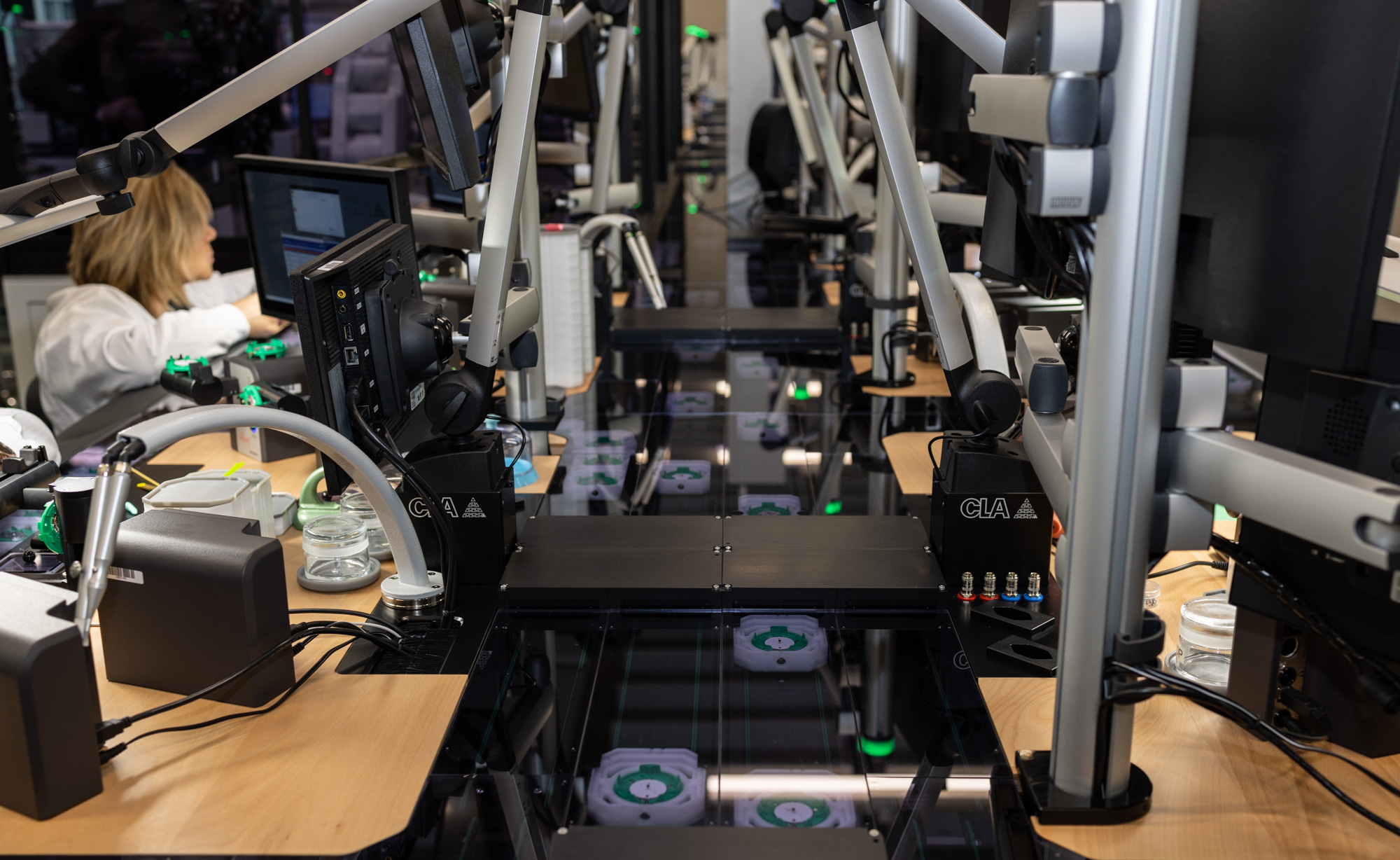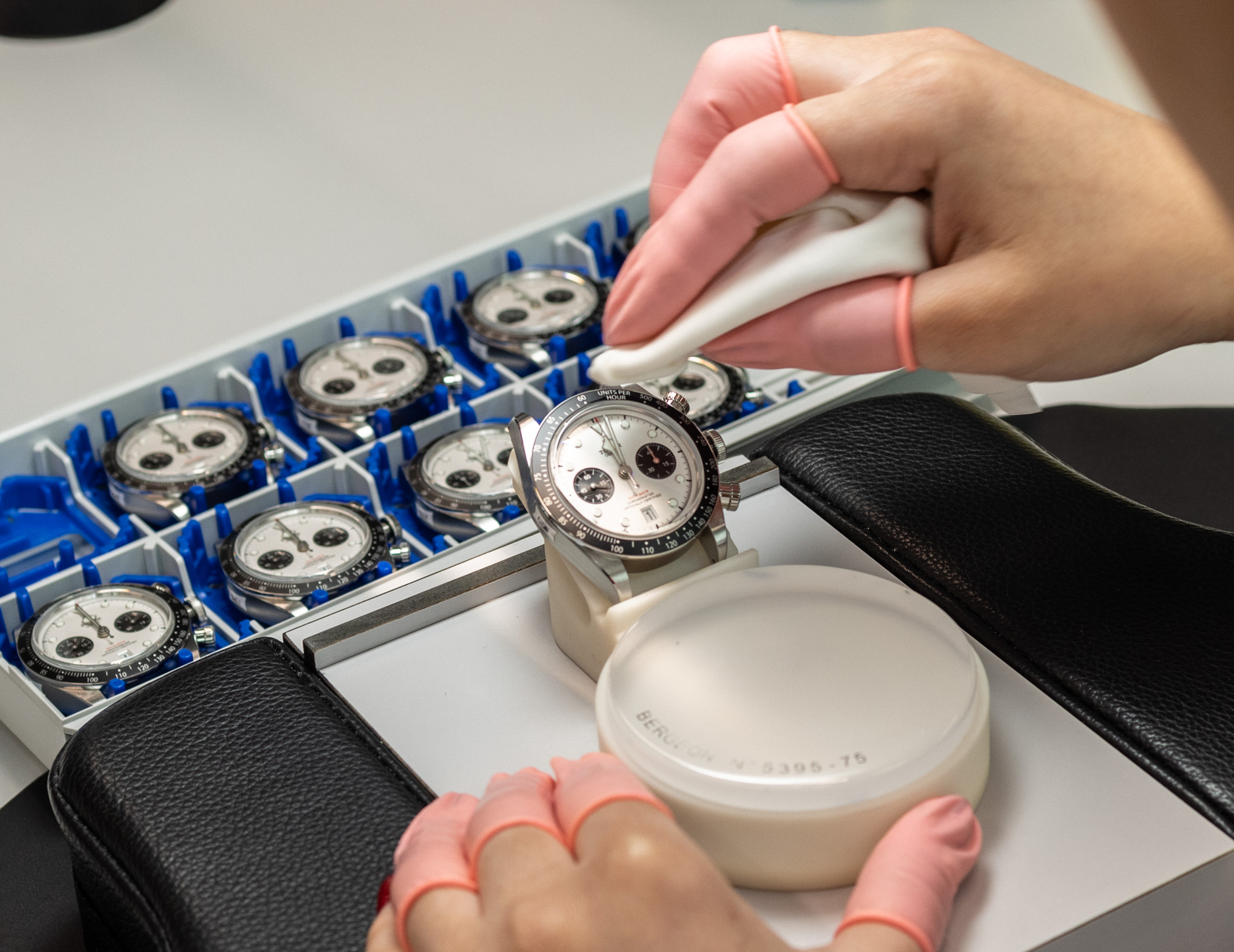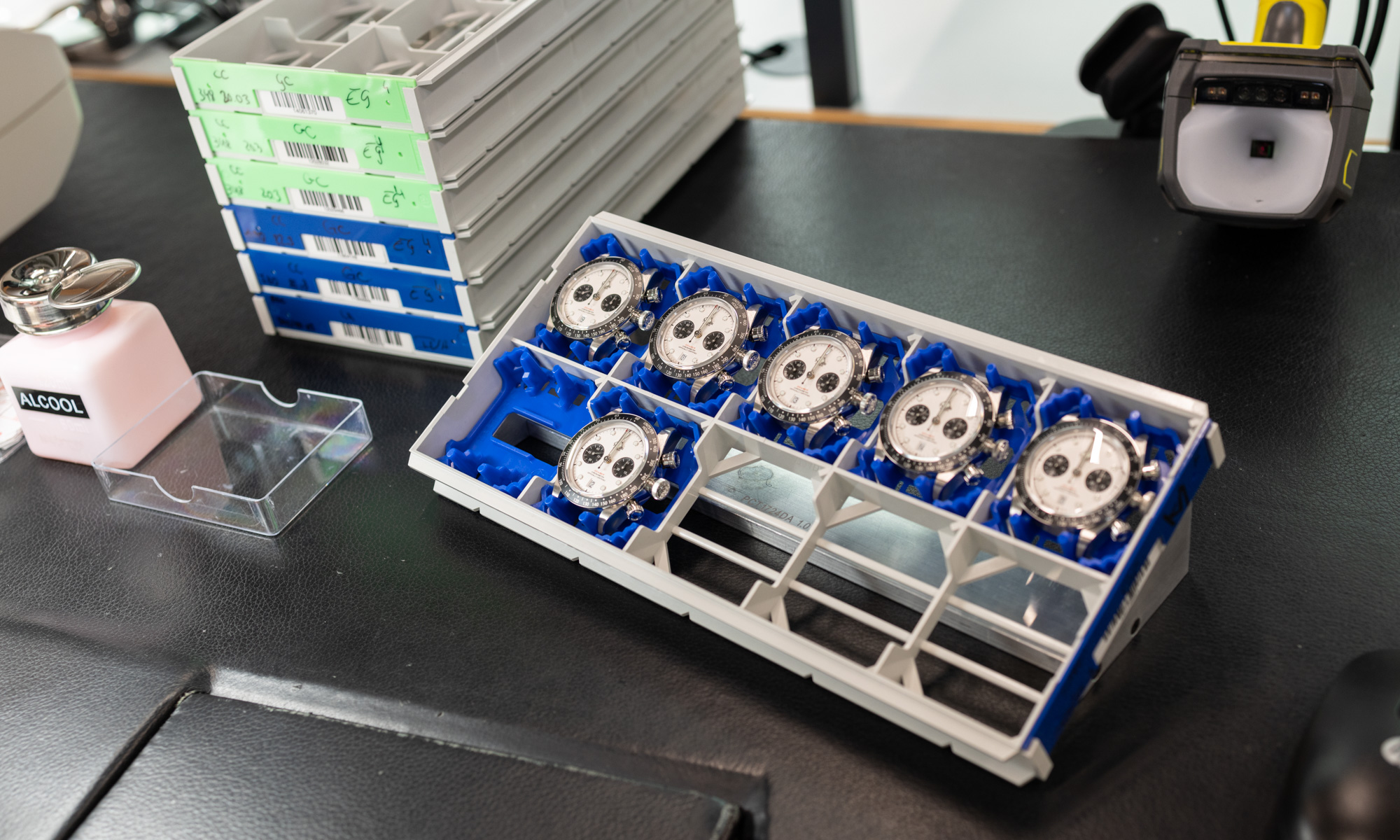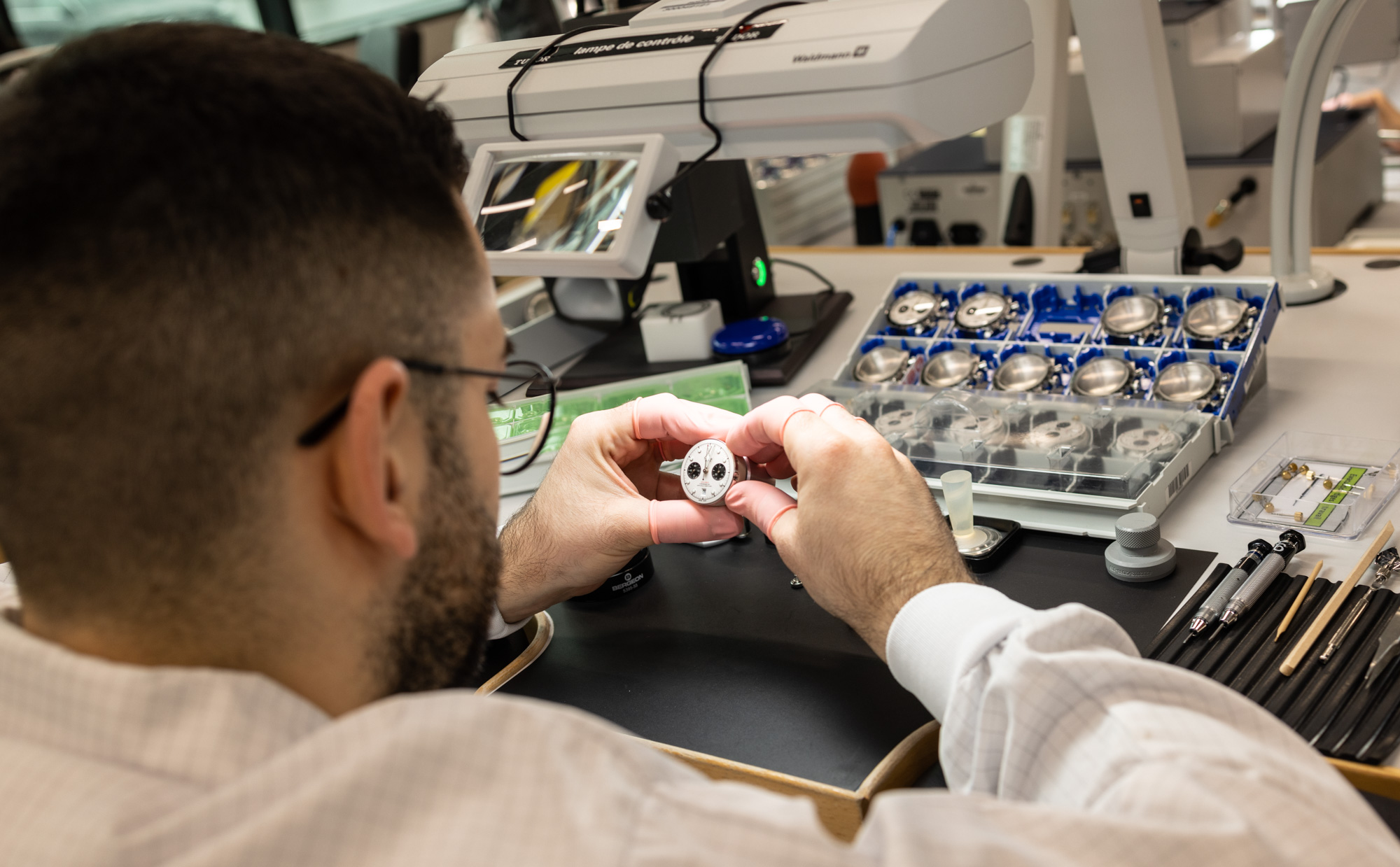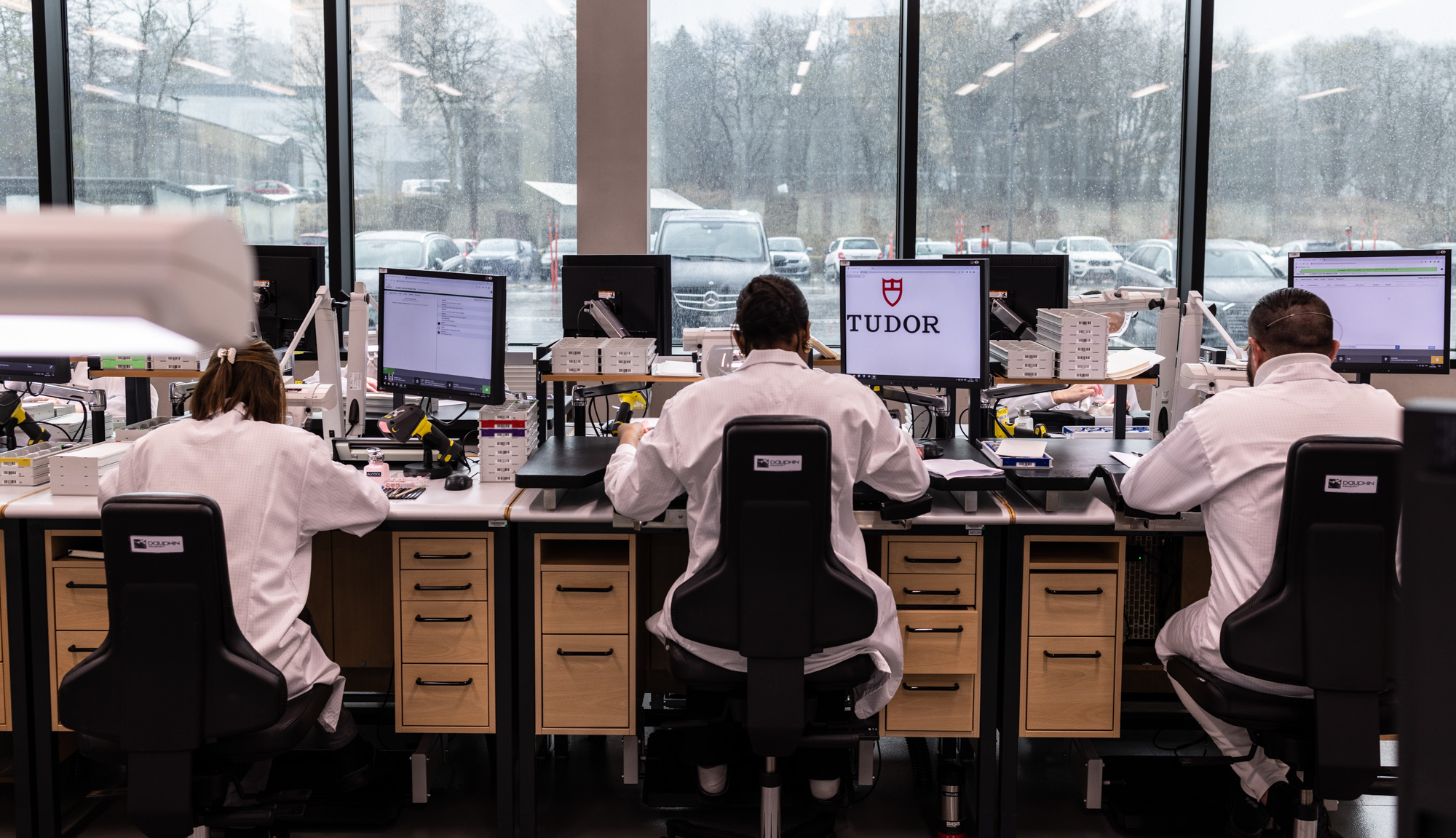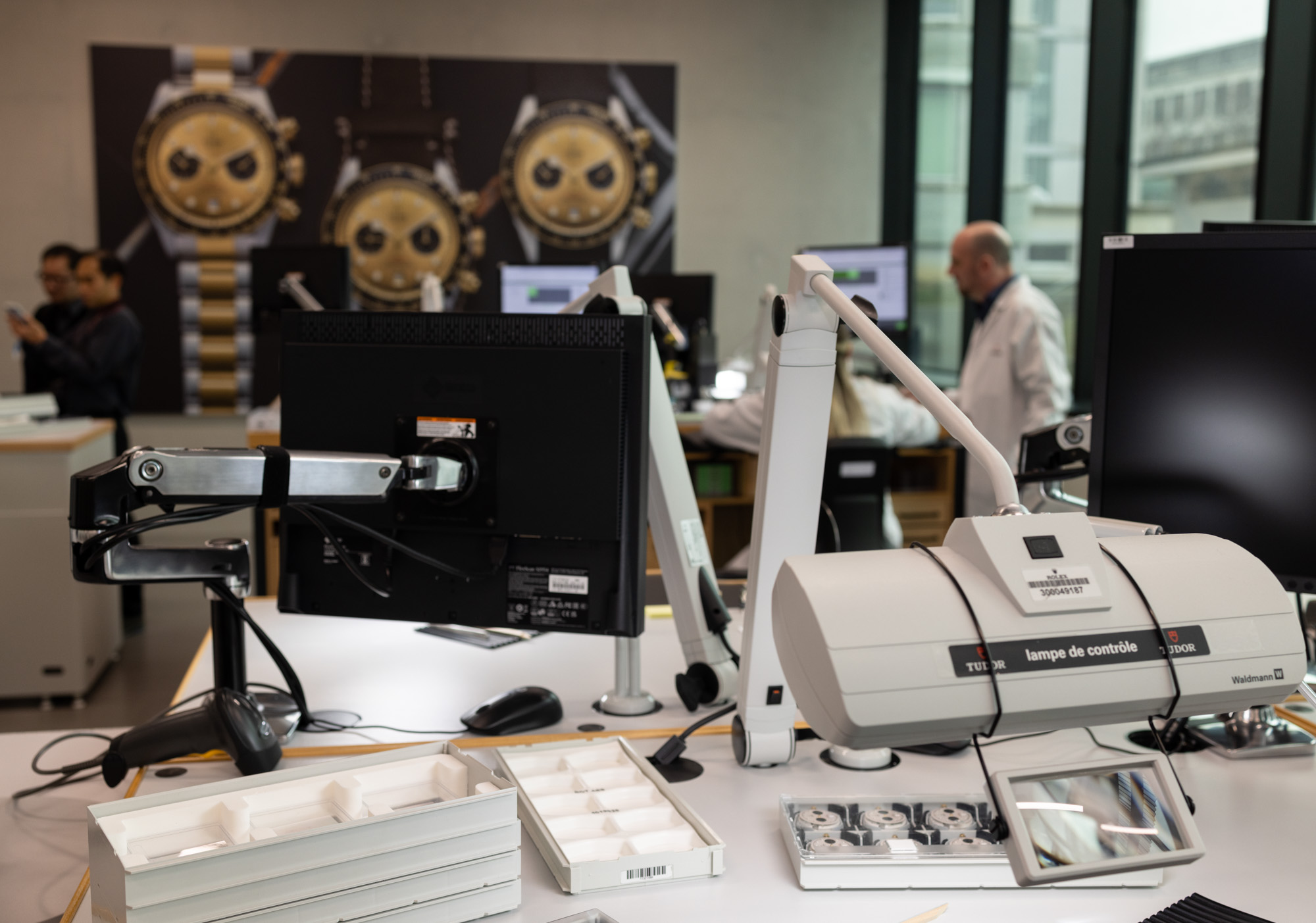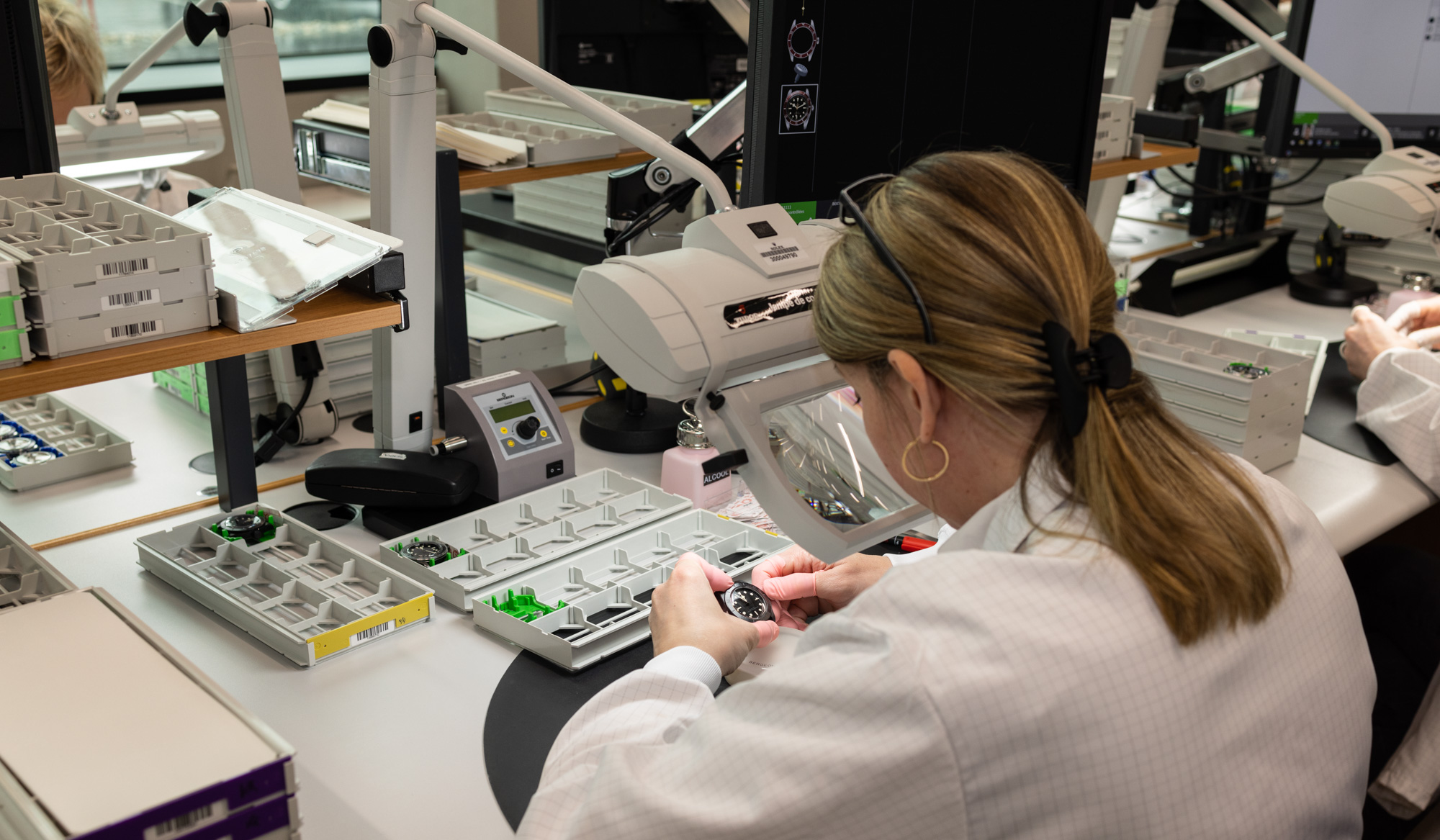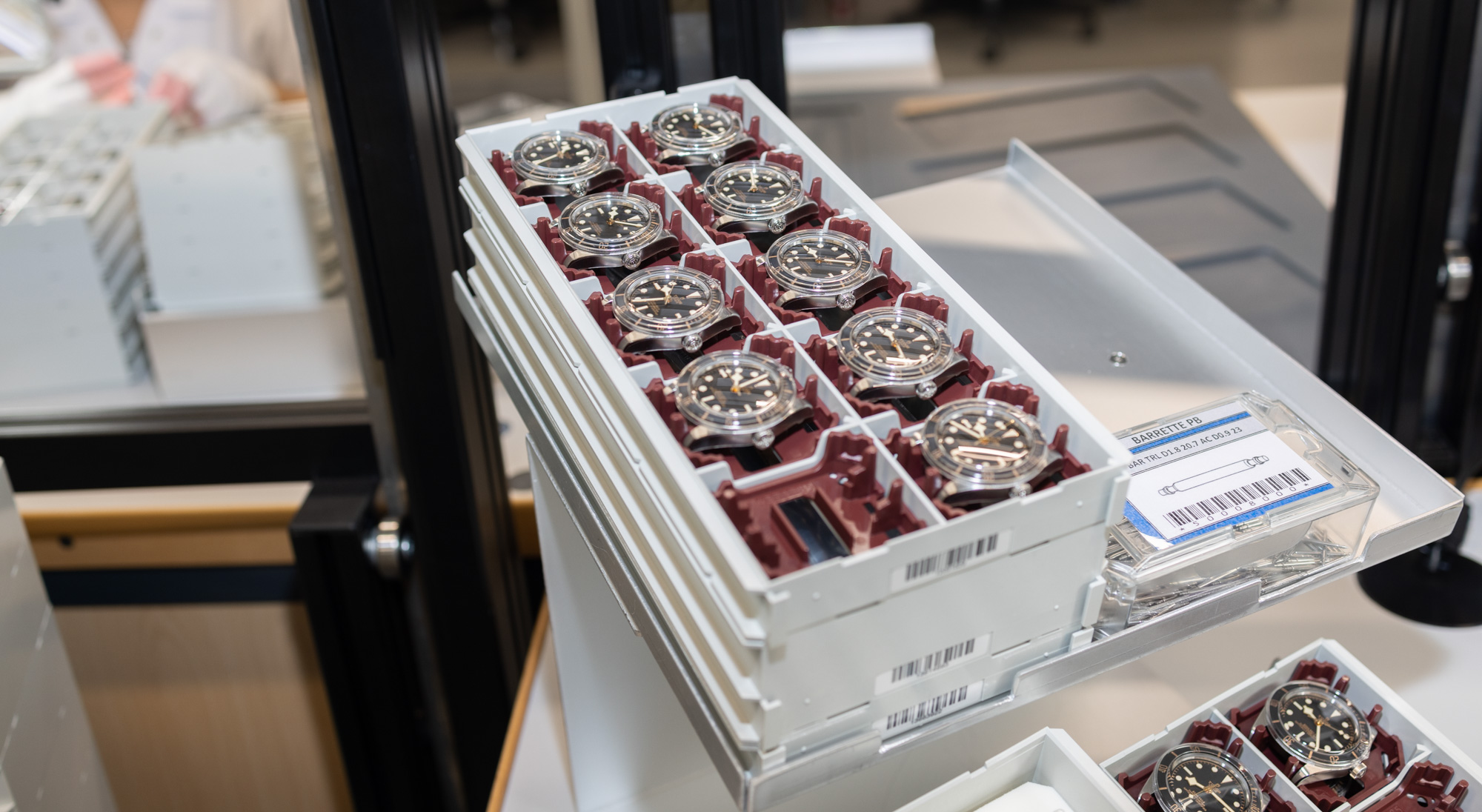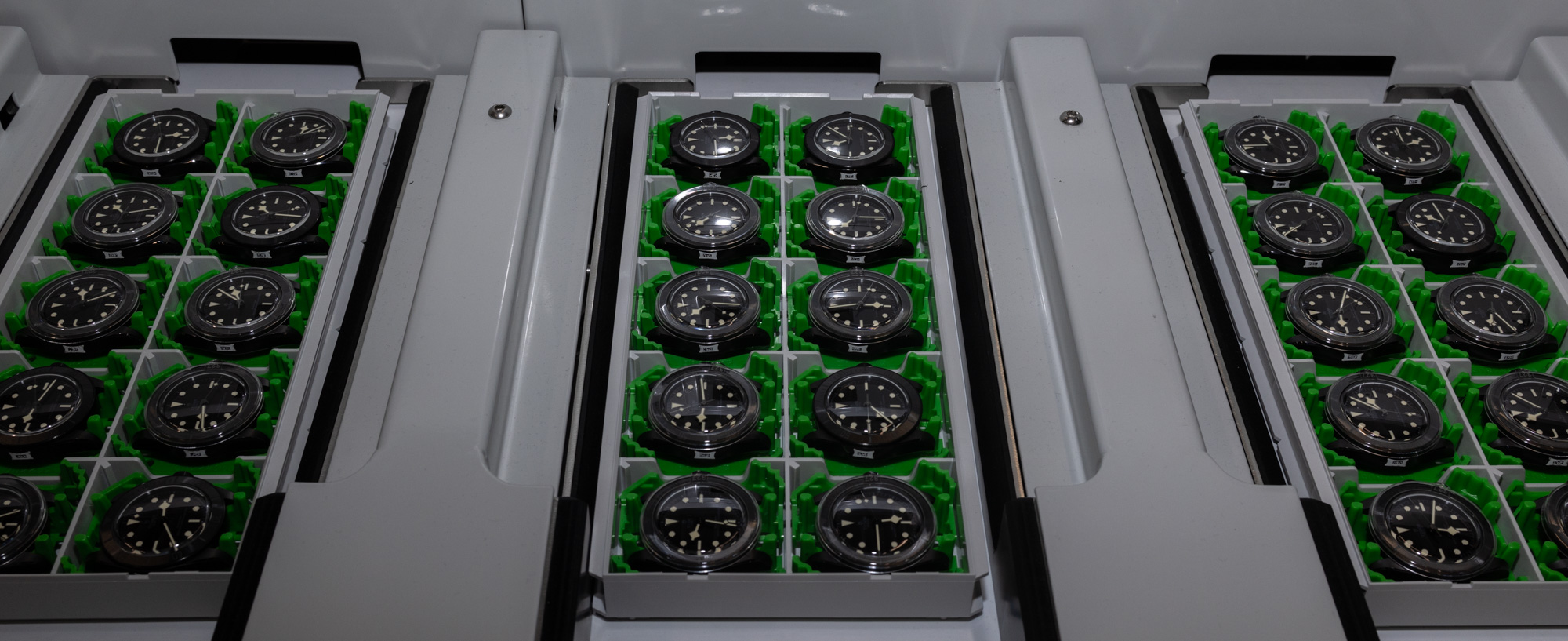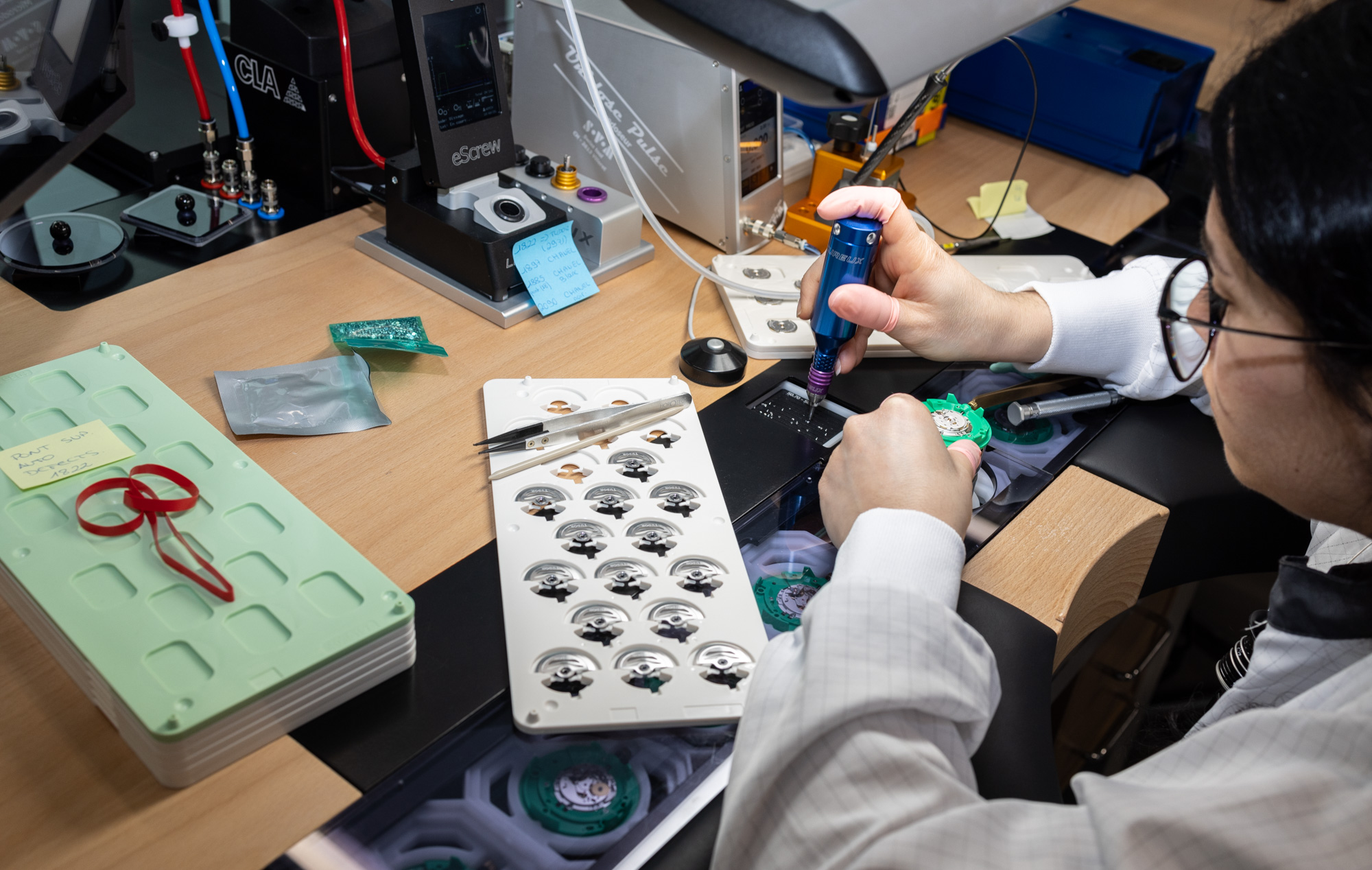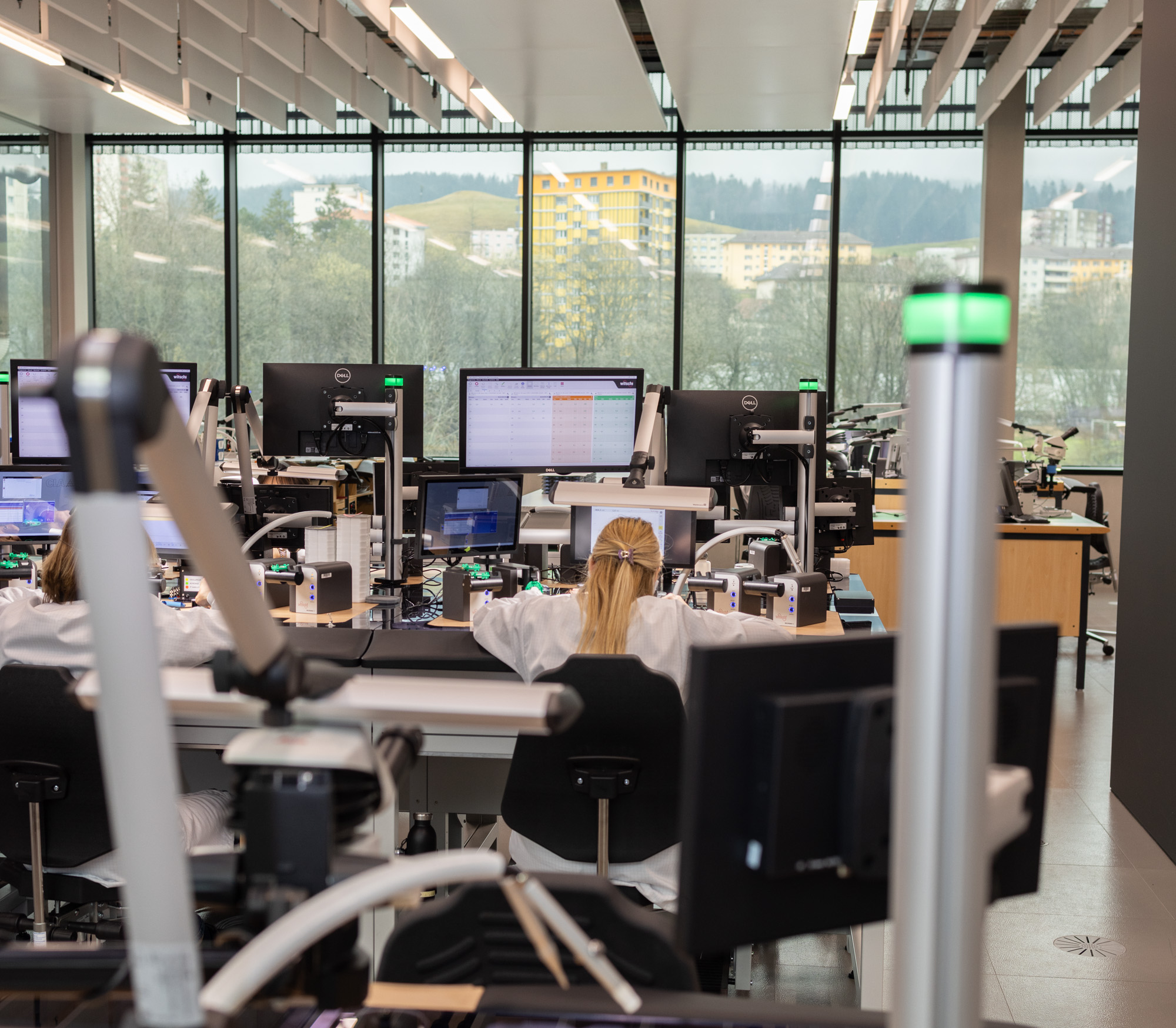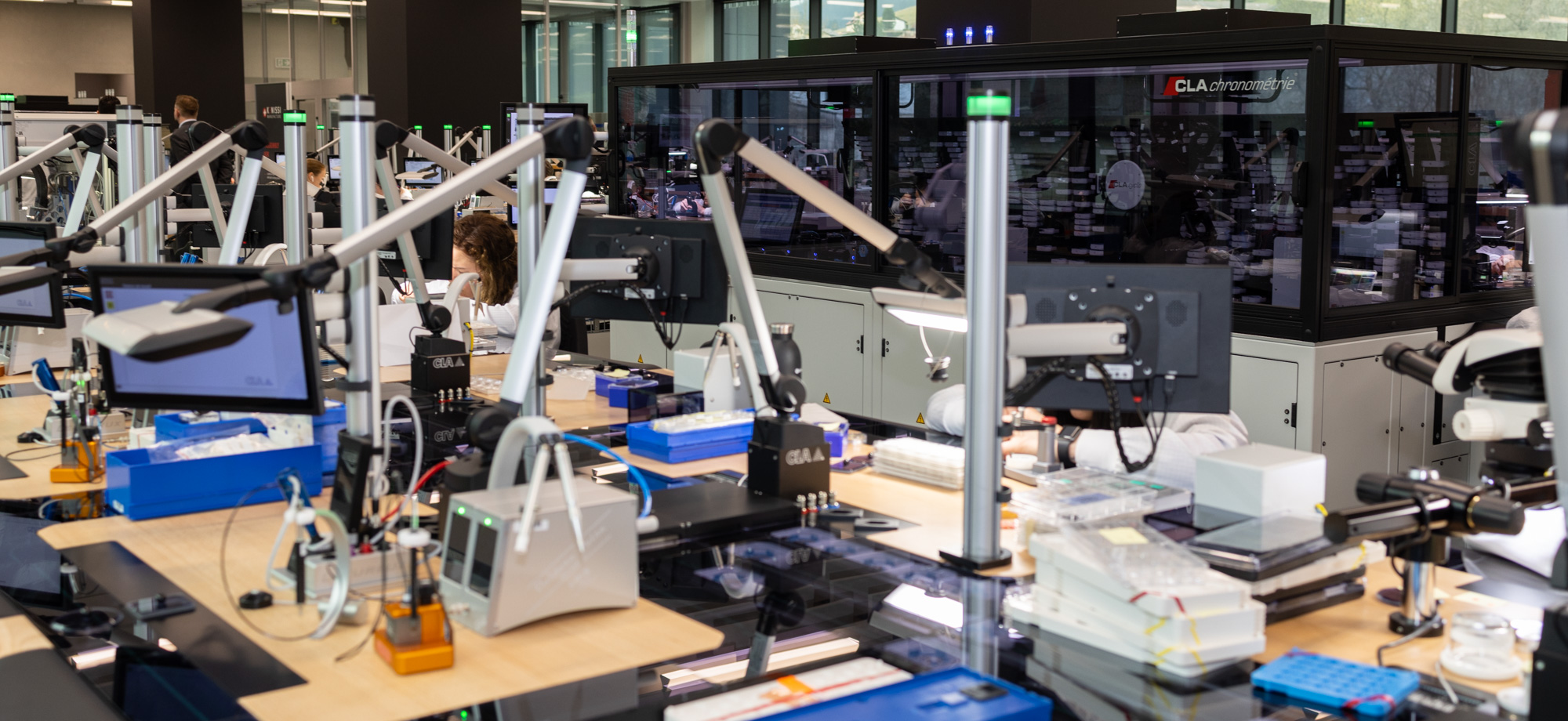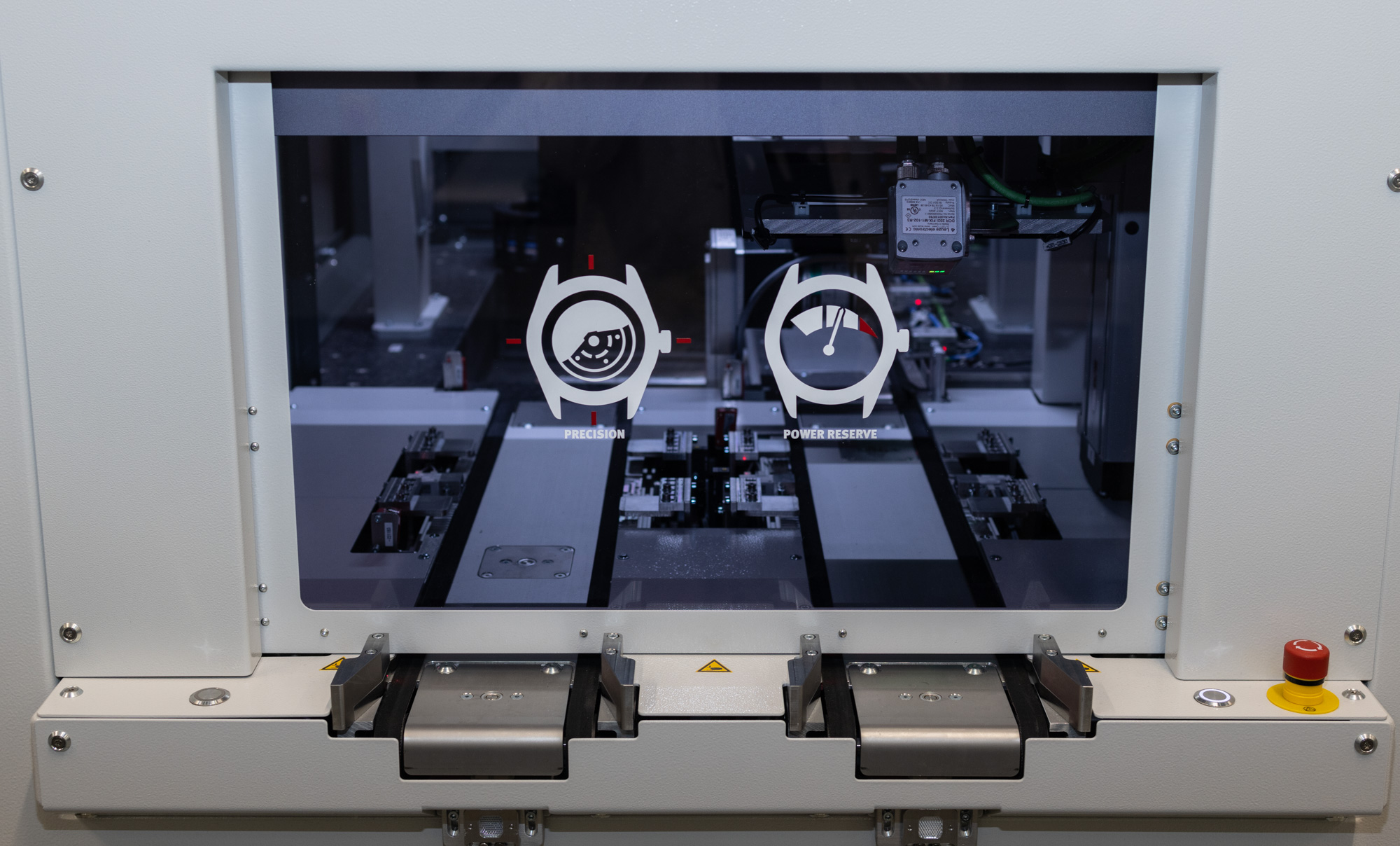
The scene was not typical even though the activity inside was routine for the region. Men in trim blue suits buzzed around as robotic arms and conveyor belts whizzed around watch parts. A watchmaker carefully eyes a dial under a magnification loupe looking for blemishes, and an industrial appliance that could easily double as a Star Wars droid ferries a tray of timepiece cases to their next station. This sci-fi combination of humans and machines is the latest and most ambitious effort to produce traditional mechanisms using some of today’s most sophisticated assembly-line technology. It helps keep costs down and quality high, and it is how Tudor makes its watches today.
In 1926, Rolex set up sister brand Tudor as a consumer entry point into watches. For years, Tudor watches were produced to be sold alongside Rolex, or in other retail channels, with Tudor always remaining a high-value, lower-priced alternative to Rolex timepieces. Tudor products have taken on a few different personalities over the years but until now have never been produced at their own dedicated facility. Now, that has all changed. This year, Tudor opens up its first-ever manufacture, and aBlogtoWatch was there for the first media tour. The facility is ultra-modern and represents one of the Swiss watch industry’s most ambitious approaches yet to marrying traditional artisanship to modern engineering and manufacturing excellence.

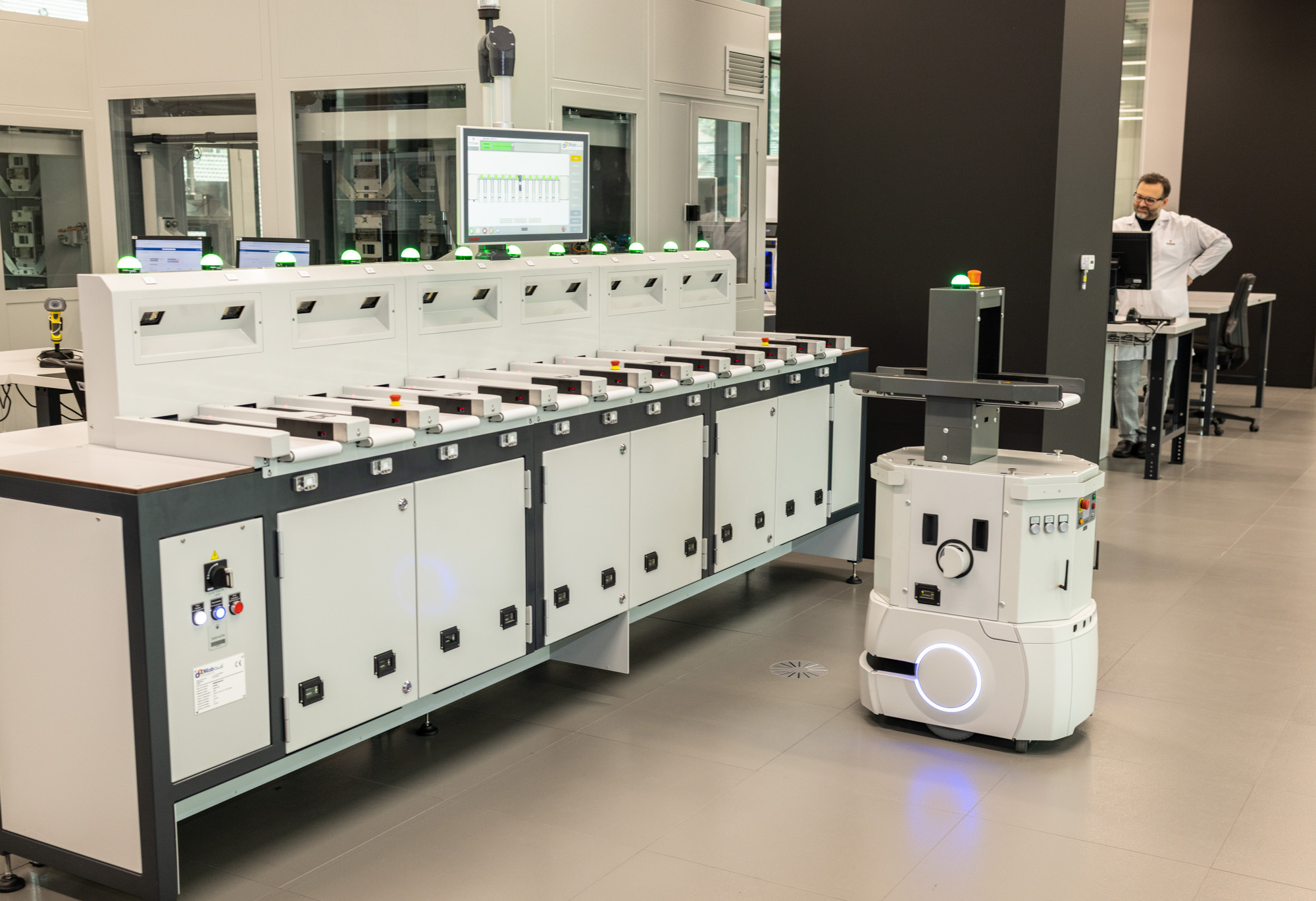
Like Rolex, Tudor is officially headquartered in Geneva but now has its production facility elsewhere — in LeLocle, Switzerland (Rolex produces its movements in Biel/Bienne). Le Locle is a historic watchmaking town in Switzerland and is home to a number of other watch brands and movement-making facilities. It is now also home to the Tudor Manufacture and companion Kenissi movement production company, all under one roof. It represents a strengthening of the Tudor brand, along with a move toward more independence and less oversight from Rolex directly. While top-level company decisions still involve Rolex, today, Tudor is running things its way more than ever.
Part of running Tudor today is also running Kenissi, a separate company that produces mechanical watch movements. Kenissi operates as a supplier to a growing number of watch brands and began alongside the development of movements designed for Tudor brand models in 2010. Tudor and Rolex made the decision that the development of the new Tudor calibers could be applied to the creation of base movements which could be sold to third-party companies. Tudor unveiled its first in-house movements (entirely different from Rolex movements, and also not like the ETA movements previously used in most Tudor watches) in 2015. A year later, in 2016, Kenissi was formed.
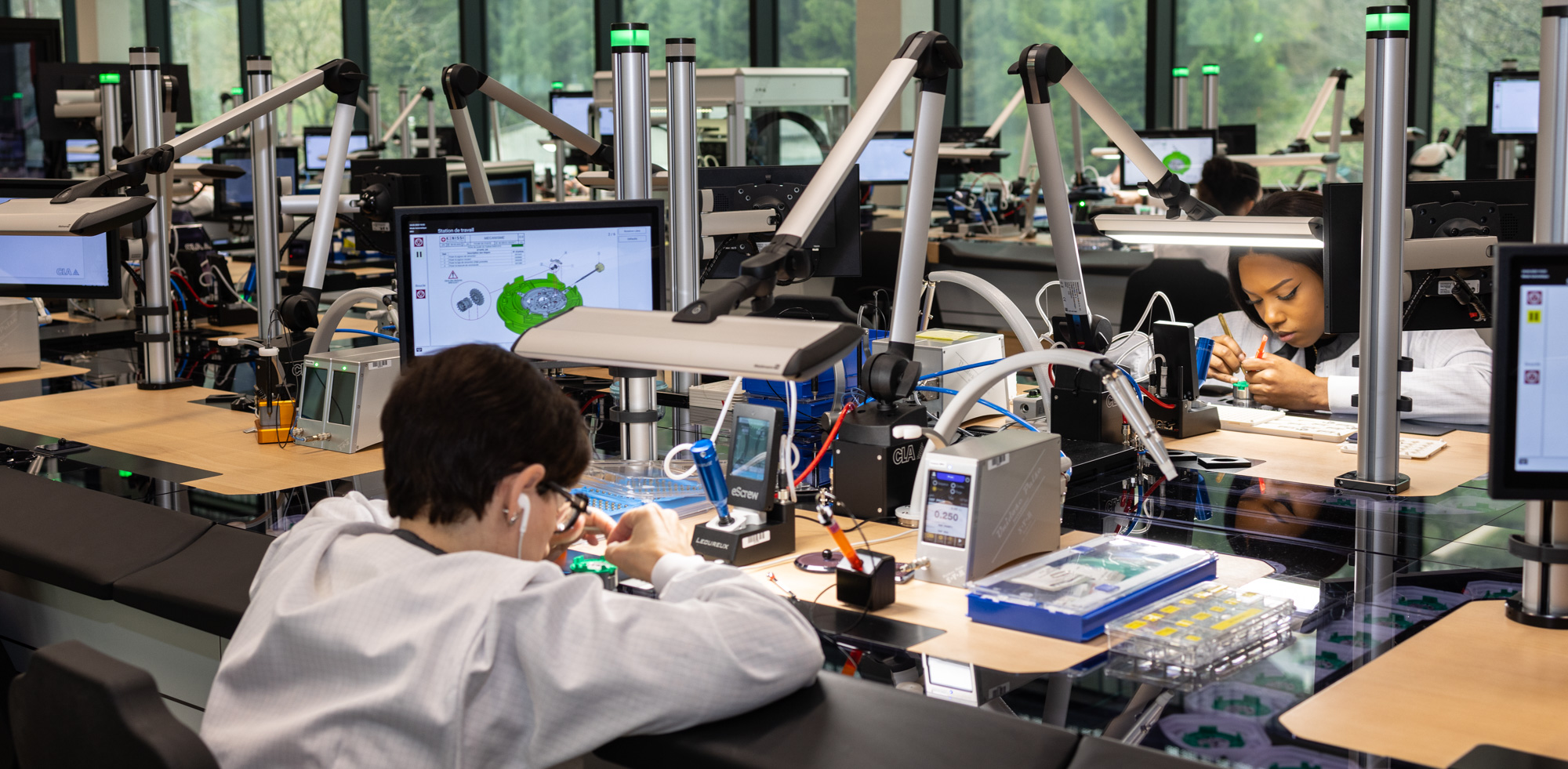
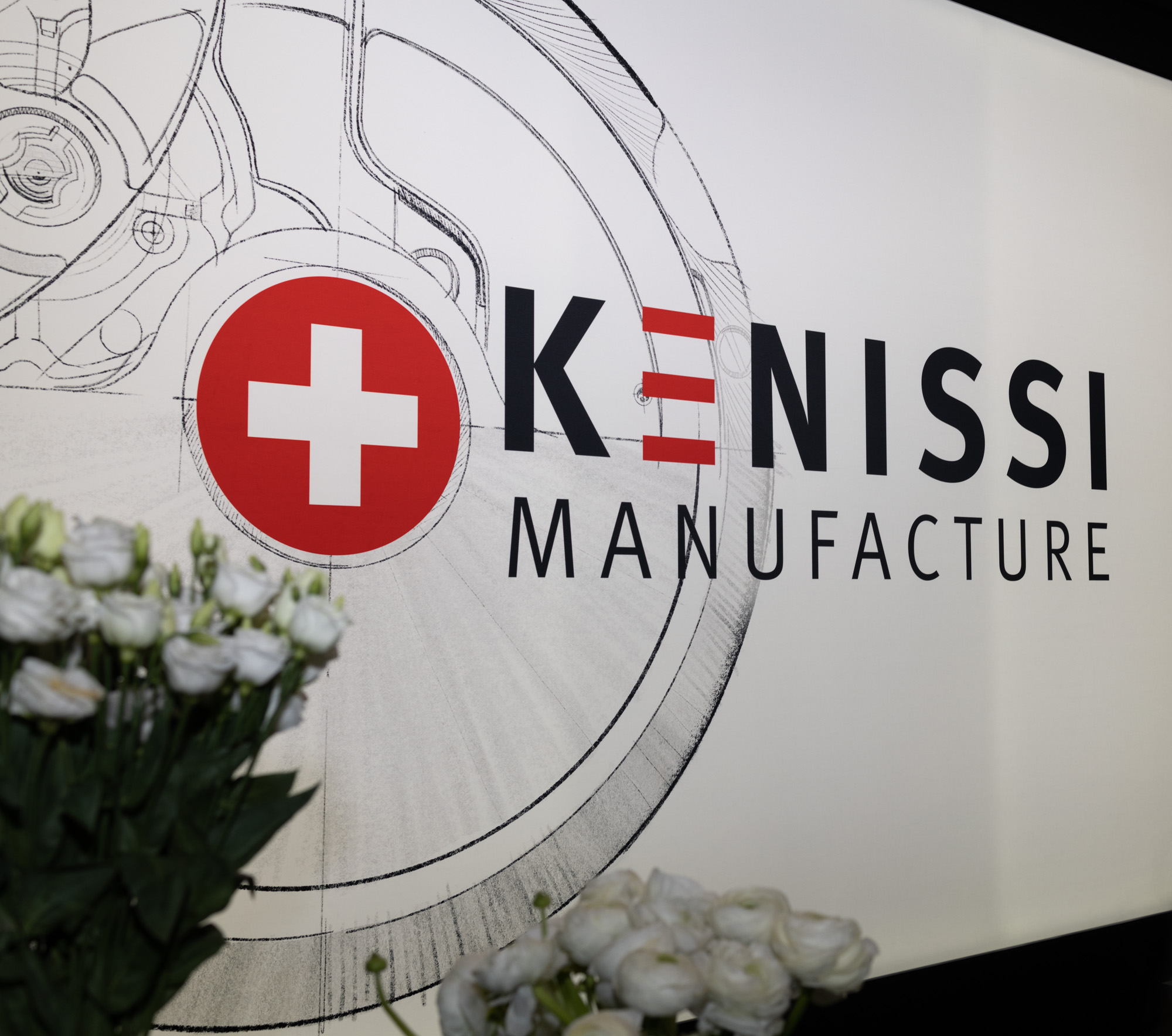
Kenissi accepted a 20% purchase stake from Chanel in 2018 in order to jointly take on the mission of developing the manufacturing capacity of the new movement-making company. Accordingly, Kenissi movements are featured in many Chanel timepieces. Otherwise, Kenissi is controlled by Tudor — perhaps a given being that it is where Tudor’s movements are produced. The new facility in Le Locle is split between the Tudor and Kennisi areas, but the operation of the companies is intertwined. There is real excitement in the air because all of this is very new to the Rolex family. After nearly 100 years in existence, Tudor is finally out on its own a bit, and with its newfound independence is the important responsibility of ensuring movement production efficiency, one of the absolute hardest things to master in the area of watchmaking. The idea is that it is easy to produce a small number of watch movements if you have lots of time. Alternatively, it becomes very difficult to produce a large number of watch movements in a short period of time — if you aren’t armed with “The Rolex Way.”
I’ve been to where Rolex produces watches and have been able to compare and contrast it with the Tudor Manufacture. Much of the same philosophy abounds, namely the use of automation to assist human effort in order to promote quality (more so than costs). The reality is that designing, building, and maintaining a watch factory that employs robots and a large amount of automation is hugely expensive. What Tudor gains from this extremely modern approach is speed and efficiency. It affords the brand the ability to produce very high-performance watch movements quickly and consistently. Tudor now produces many of the watch movements used in their timepieces and openly relies on a mixture of third-party suppliers for the rest of its watch components. Some of the entry-level Tudor watches – for value purposes – contain Swiss Made ETA movements. The in-house Tudor movements aren’t just “Swiss Made,” but made from parts that are all manufactured in Switzerland. All the Tudor watches that contain in-house movements will eventually (there is no specific date in mind, but it is a goal that Tudor is working toward) also be certified as Master Chronometers.
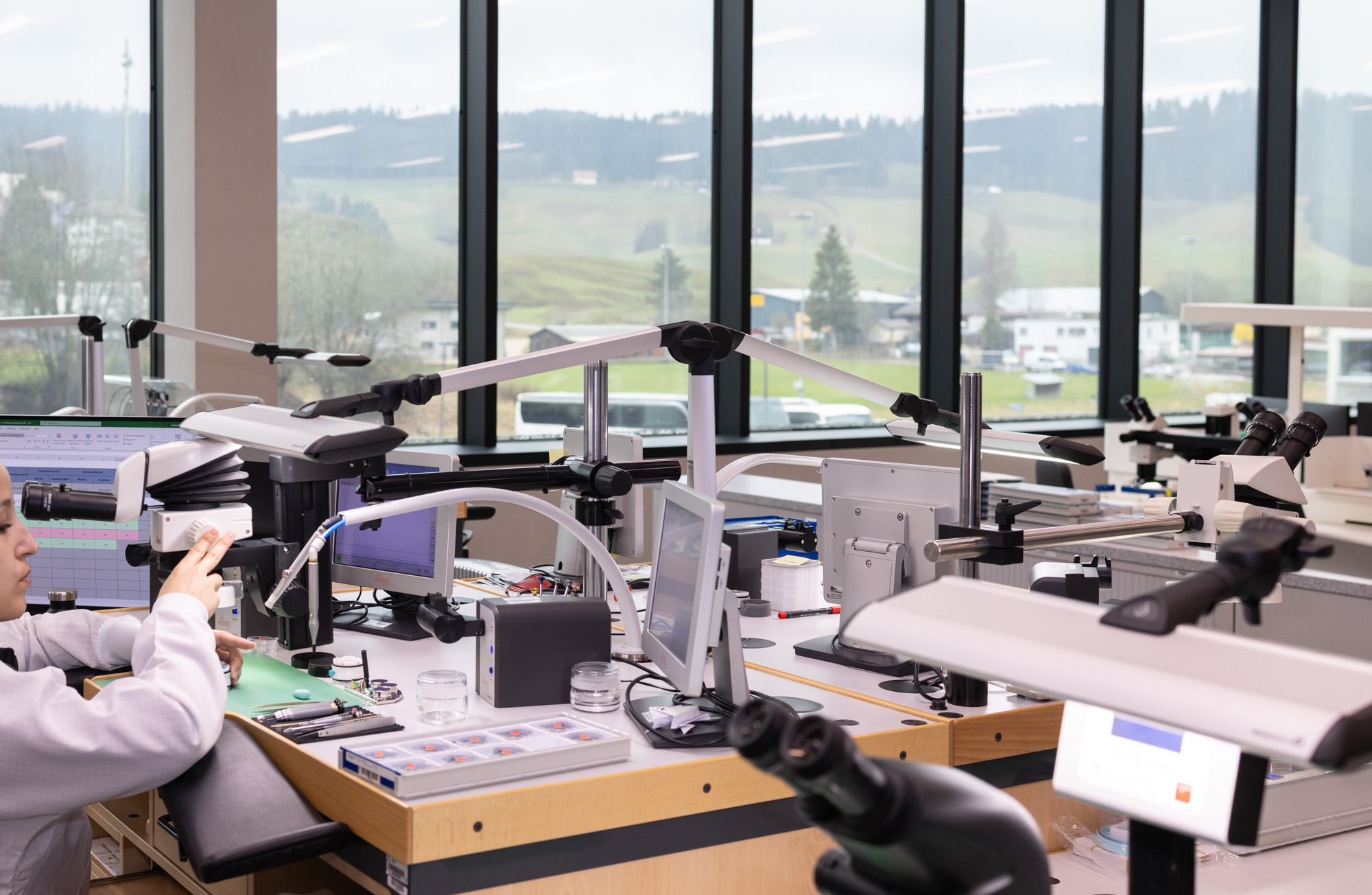
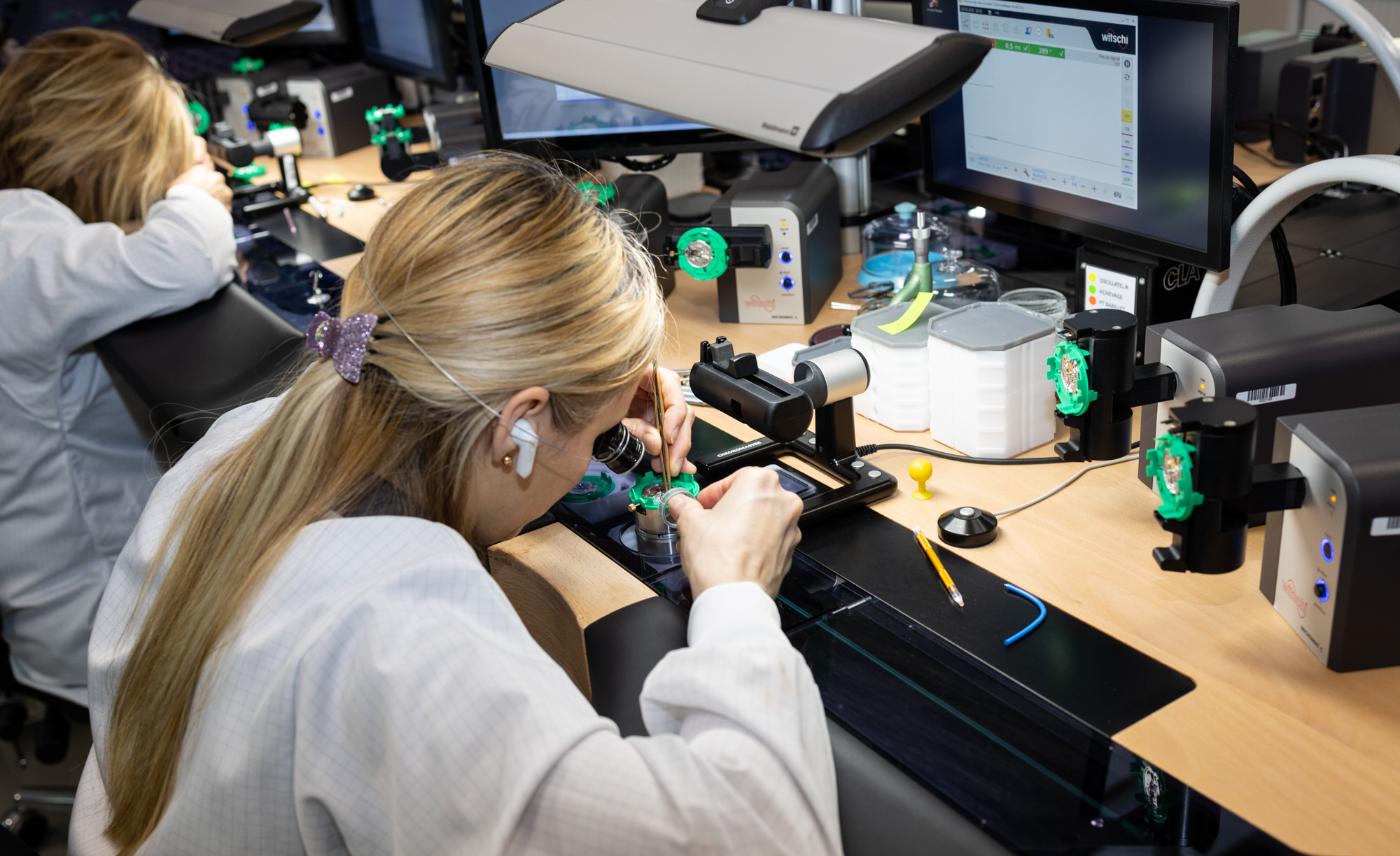
Currently, only a small number of Tudor watches are given METAS certification and are thus considered to be “Master Chronometers.” The designation is far more meaningful than COSC Chronometer certification, if only because it tests for more serious reliability and occurs when a movement is actually inside the fully-cased watch (COSC only tests bare movements). METAS certification also tests for important things like magnetic resistance, which Master Chronometers excel at given their a-magnetic movement parts. Tudor has set up a full METAS certification section at its factory in anticipation of more and more of movements bearing this important certification standard, which, until recently, was only used by Omega. The prospect is exciting for Tudor fans and consumers who have high performance expectations from their timepieces.
The reason I feel most watch lovers should be interested in the Tudor Manufacture is specifically because it isn’t trying to be about luxury. This is a place for machine and construction nerds. It is a place where you can get excited about the innovative and rapid way the building was designed and constructed to be efficient and friendly. It is a place where you can marvel at how extremely sophisticated tools and systems are used to track and move watch parts around so that humans can maximize their time doing actual watchmaking. The entire factory is a lot like a watch mechanism itself. Tudor has designed it to, as autonomously as possible, take in raw components and put out high-quality watches. It is a marvel and Tudor/Rolex are true masters of this game. In the Swiss wristwatch world, there is very little out there like it.
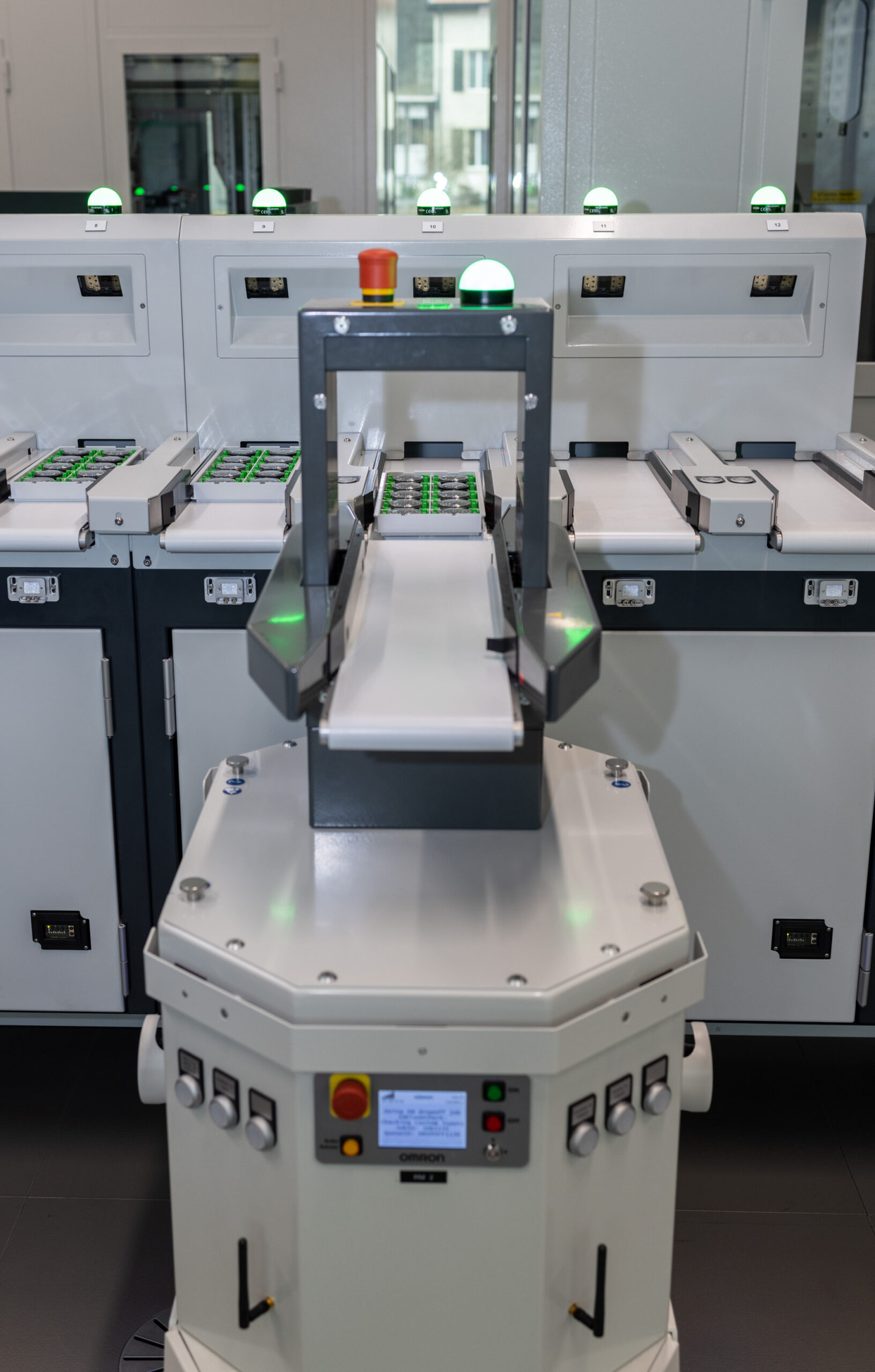
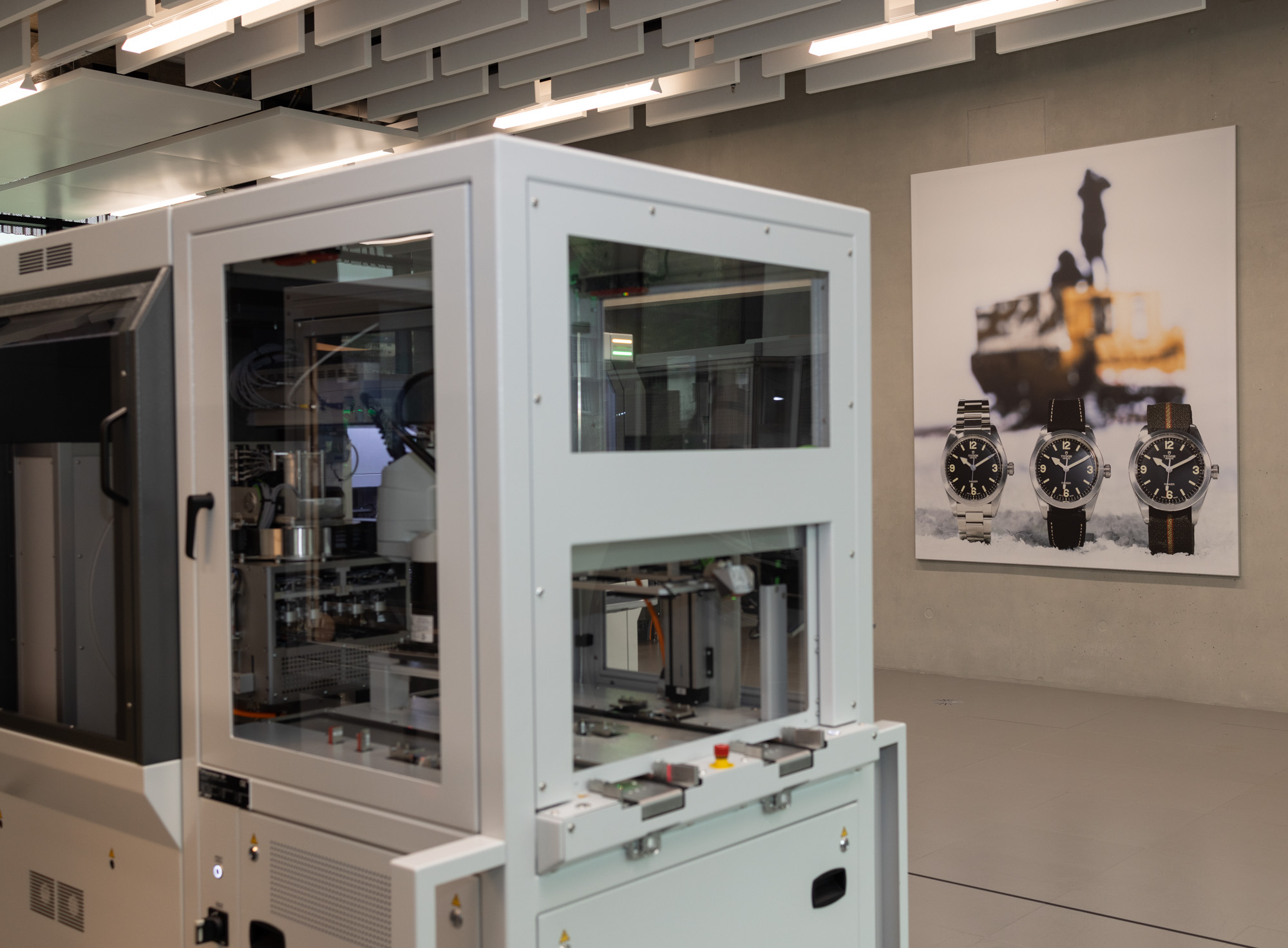
The Tudor/Rolex Way is really a method or approach to design, manufacturing, and operation. It is applied to watches but can really be applied to almost anything that is constructed. The Tudor Manufacture itself and the product assembly system within it is a perfect example of that notion in action. Tudor demonstrates an honest commitment to its brand by creating something world-class and very contemporary but that doesn’t overshadow Rolex or needlessly increase costs for consumers. The resulting feeling is that Tudor’s products are extremely carefully made but also not priced higher than they need to be. Value is increasingly becoming important for watch buyers around the world, and brands have a duty to fully explain how and why their products are worth it. Tudor has been on a roll in this department, and the addition of the dedicated Tudor Manufacture appreciably adds to the brand’s prestige as well as legitimacy in being its own brand outside of the looming Rolex shadow.
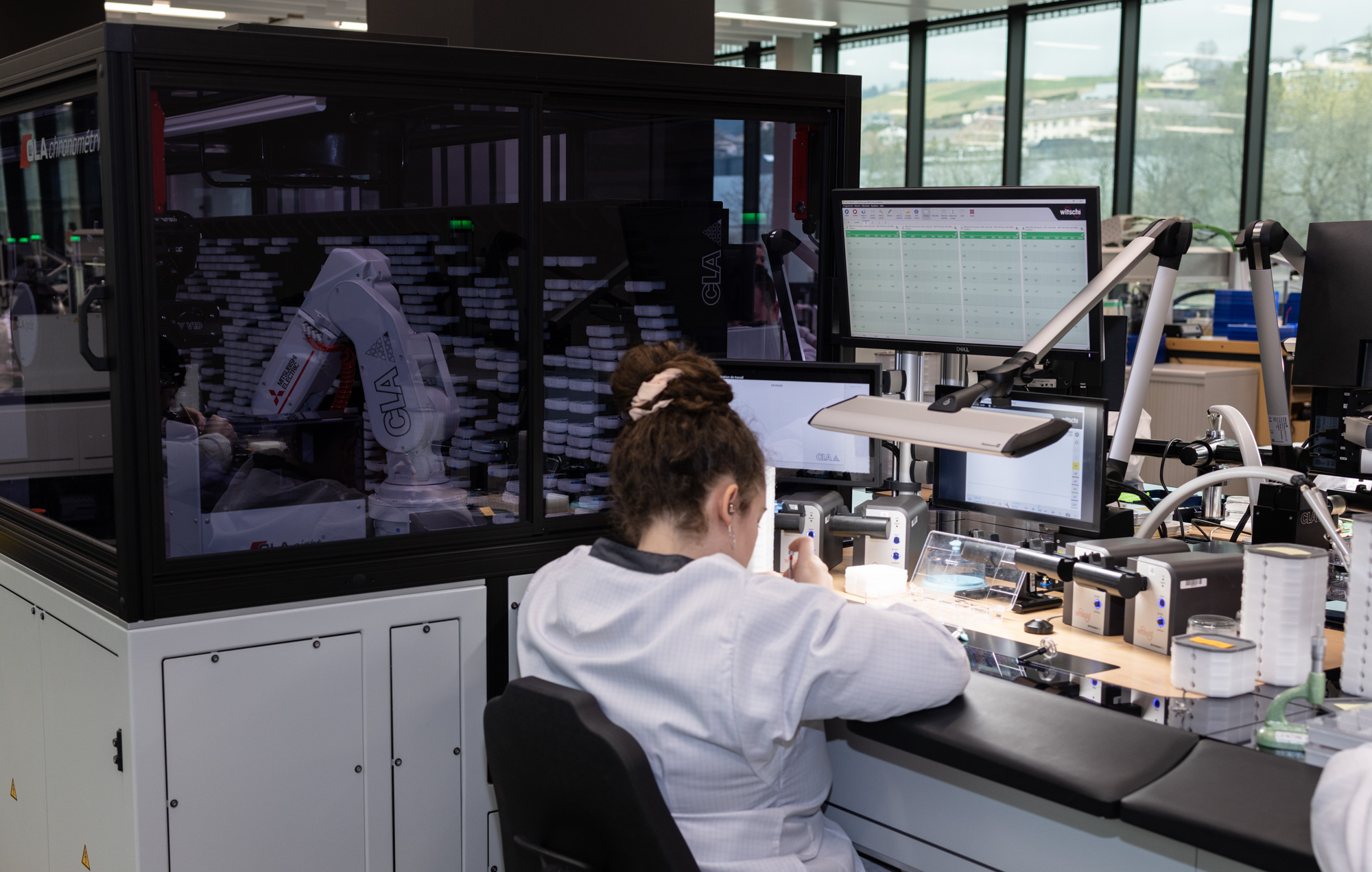
Tudor is making market gains across the world, as it has steadily been doing since the brand was revitalized a few years ago. Much of the company’s marketing is to younger buyers and those not yet ready (or able) to purchase a Rolex watch. That makes sense, but young or new watch buyers are hardly the only people who can appreciate what Tudor is doing. Collectors and enthusiasts are increasingly interested in Tudor because of its strong tool watch offerings with increasingly high-performance movements and modern takes on classic sporty designs. Mature wearers are choosing Tudor timepieces as weekend or even daily wearers because of their accessibility and approachability. To be equally compelling to novice and seasoned timepiece enthusiasts alike is a very uncommon position for any brand to be in – and yet Tudor has perfectly aligned itself for success in this position. It will still take a few years before your average watch buyer fully understands today’s Tudor story, but once they do, the relationship they will form will be lasting. Learn more at the Tudor watches website.

